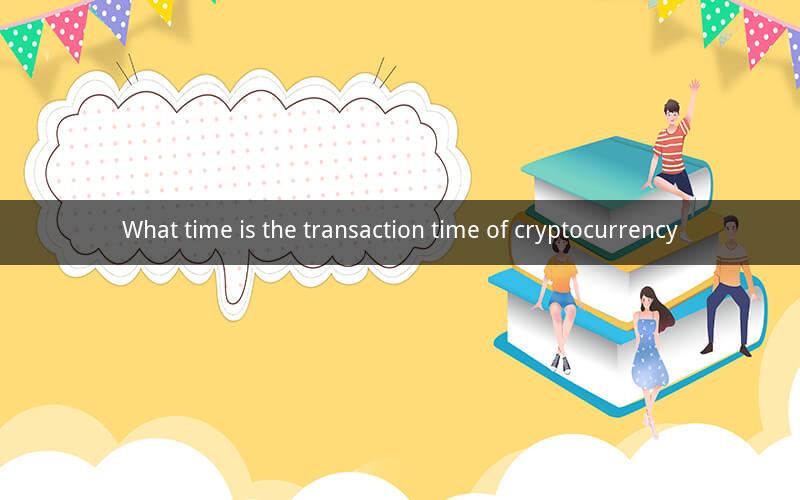
Contents
1. Understanding Cryptocurrency Transactions
2. Factors Influencing Transaction Time
3. Blockchain Technology and Transaction Time
4. The Role of Miners in Cryptocurrency Transactions
5. Transaction Time Across Different Cryptocurrencies
6. Improving Transaction Time in Cryptocurrency Networks
7. Challenges in Reducing Cryptocurrency Transaction Time
8. The Impact of Transaction Time on Cryptocurrency Adoption
9. Future Outlook for Cryptocurrency Transaction Time
10. Conclusion
1. Understanding Cryptocurrency Transactions
Cryptocurrency transactions involve the exchange of digital assets, typically represented by cryptographic tokens, between two parties. Unlike traditional financial transactions, which are processed through centralized systems, cryptocurrency transactions are decentralized and recorded on a blockchain, a public ledger of all transactions.
2. Factors Influencing Transaction Time
Several factors can influence the time it takes for a cryptocurrency transaction to be confirmed and completed. These include the network's congestion, the size of the transaction fee, and the mining difficulty of the specific cryptocurrency.
3. Blockchain Technology and Transaction Time
Blockchain technology underpins cryptocurrency transactions. Each block contains a set of transactions, and once a block is confirmed, the transactions are considered complete. The time it takes for a block to be added to the blockchain is what determines the transaction time.
4. The Role of Miners in Cryptocurrency Transactions
Miners play a crucial role in the cryptocurrency ecosystem. They validate transactions, create new blocks, and add them to the blockchain. In exchange for their efforts, miners receive a reward in the form of the cryptocurrency they are mining.
5. Transaction Time Across Different Cryptocurrencies
Transaction times can vary significantly across different cryptocurrencies. For instance, Bitcoin transactions typically take around 10 minutes to be confirmed, while Ethereum can take as little as 15 seconds.
6. Improving Transaction Time in Cryptocurrency Networks
Several methods are being explored to improve transaction time in cryptocurrency networks. These include increasing the block size, implementing off-chain scaling solutions, and optimizing the consensus algorithm.
7. Challenges in Reducing Cryptocurrency Transaction Time
Despite ongoing efforts to improve transaction time, several challenges remain. These include the need to balance security with efficiency, the difficulty of scaling while maintaining decentralization, and the regulatory landscape.
8. The Impact of Transaction Time on Cryptocurrency Adoption
Transaction time is a critical factor in the adoption of cryptocurrencies. Longer transaction times can deter users from engaging with the ecosystem, while faster transaction times can make cryptocurrencies more practical for everyday use.
9. Future Outlook for Cryptocurrency Transaction Time
The future of cryptocurrency transaction time looks promising. With ongoing technological advancements and increased industry collaboration, it is expected that transaction times will continue to decrease, making cryptocurrencies more accessible and efficient.
10. Conclusion
Understanding the transaction time of cryptocurrencies is essential for anyone interested in participating in the digital asset ecosystem. By considering the various factors influencing transaction time and the ongoing efforts to improve it, we can better appreciate the dynamics of the cryptocurrency market.
Questions and Answers
1. Q: What is the primary difference between blockchain and traditional banking systems?
A: The primary difference is that blockchain is decentralized, while traditional banking systems are centralized.
2. Q: How does the transaction fee affect transaction time?
A: Higher transaction fees can incentivize miners to prioritize transactions, resulting in faster confirmation times.
3. Q: Can transaction time be affected by the geographical location of the sender and receiver?
A: Yes, network latency can affect transaction time, particularly for cross-border transactions.
4. Q: What are off-chain scaling solutions?
A: Off-chain scaling solutions, such as the Lightning Network, allow transactions to be processed outside the main blockchain, improving transaction speed.
5. Q: How does the mining difficulty impact transaction time?
A: Higher mining difficulty means it takes longer for a block to be confirmed, which can increase transaction time.
6. Q: Are there any legal implications for cryptocurrency transactions?
A: Yes, cryptocurrency transactions may be subject to regulations depending on the jurisdiction.
7. Q: How does the size of a transaction affect transaction time?
A: Larger transactions may take longer to confirm due to network congestion and the need for more computational resources.
8. Q: Can a cryptocurrency transaction be reversed?
A: Unlike traditional banking systems, cryptocurrency transactions are irreversible.
9. Q: How do cryptocurrencies differ from fiat currencies in terms of transaction time?
A: Cryptocurrency transactions are generally faster than traditional banking transactions, with confirmation times ranging from seconds to minutes.
10. Q: What role does consensus algorithm play in transaction time?
A: The consensus algorithm determines how blocks are added to the blockchain, which can affect transaction time.